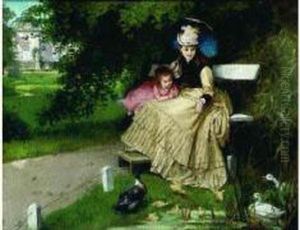Friedrich Franz Ma. Stummel Paintings
Friedrich Franz Matthias Stummel, born on January 20, 1850, in Koblenz, Germany, was a prominent stained glass artist and painter during the late 19th and early 20th centuries. His work was closely associated with the revival of religious art in Germany, particularly within Catholic circles. He was a part of the broader movement of historicism, which sought to rekindle the styles and techniques of the past, especially those of the Middle Ages, and adapt them to contemporary artistic expression.
Stummel began his artistic education at the Düsseldorf Art Academy, where he studied from 1867 to 1871. There, he was exposed to the teachings of Wilhelm Sohn and Eduard von Gebhardt, influential figures who shaped his early approach to art. Stummel was deeply interested in medieval art and the Nazarene movement, which emphasized spirituality and purity in art and was inspired by the early Renaissance period.
After completing his studies, Stummel traveled extensively throughout Europe, including Italy, where the Renaissance masters left a lasting impression on him. Eventually, he settled in Kevelaer, a pilgrimage town in the Lower Rhine region of Germany, known for its Marian devotion. It was here that Stummel started to focus on religious themes, producing works that were marked by their intricate design and vibrant use of color.
Stummel's reputation grew with his work on stained glass windows for churches, which was a significant part of his oeuvre. He was particularly known for his ability to harmonize modern techniques with the spiritual and aesthetic sensibilities of historical ecclesiastical art. His windows can be found in many churches across Germany and in other countries.
In addition to stained glass, Stummel was a skilled fresco painter, and he worked on a number of important commissions throughout his career. His work often conveyed a strong narrative element, and he was praised for his ability to depict biblical scenes with both emotional depth and theological accuracy.
Stummel's contributions to religious art were recognized by the Catholic Church, and in 1910 he was honored with the title of Papal Chamberlain by Pope Pius X. This distinction acknowledged not only his artistic achievements but also his commitment to the revitalization of Catholic art.
Friedrich Franz Matthias Stummel passed away on December 5, 1919, leaving behind a legacy of artistic works that continue to be appreciated for their beauty and devotion. His life's work remains an integral part of Germany's cultural heritage, particularly within the domain of religious art and architecture.
